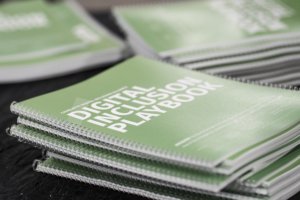Charlotte leads the state in digital inclusion programs. How can it help other communities?
A discussion with Eric Boyette, secretary of the State of North Carolina’s Department of Information Technology, reveals that Charlotte is a leading force for digital inclusion in the state. Boyette says the city’s work serves as an example for other communities.

On Sept. 27, Boyette and leaders from the City of Charlotte, Mecklenburg County, Charlotte Works, Goodwill Industries of the Southern Piedmont, EveryoneOn, E2D – Eliminate the Digital Divide, the Housing Partnership, and Queens University of Charlotte toured four city locations where work in digital inclusion is taking place. They included the university at Goodwill Industries, the ReImage Lab at West Charlotte High School, the Sprint 1Million Project at Garinger High School, and the Southside Homes project of the Charlotte Housing Authority.
The Charlotte Digital Inclusion Alliance (CDIA) released the “Digital Inclusion Playbook” during the day’s events. The playbook addresses Charlotte digital inequities and recommends strategies to begin solving them, and is available on the CDIA website. Additional details about the tour are available on the state’s Department of Information Technology website.
Highlights from an interview with Boyette at the conclusion of the tour:
1. For government organizations, what do you see as critical work still to be done to help address the issue of digital inclusion?
From a state perspective what we need to do is help, assist in any way we can with the communities. How can we help? What can we partner? Can we bring vendor partners? Can we bring some of the other communities together? To me it’s about partnerships. How do we create those partnerships and assist.
2. What are some of your reactions to what you’ve seen today?
Wow! That really sums it up. I was very impressed with not only the inclusion and the participation and partnership, but the kids. On the first stop we looked at them refurbishing the PCs and laptops, and it’s just amazing to watch those kids. They were excited about not only technology, even though when one stated that she was not going to pursue a technology career, but just to watch her in that environment and learning. Learning about responsibilities. Just that growth was just amazing to me. And the job center — being able to have a place for your assistants to come in and work with community leaders and figure out ways that they can better themselves. It was just an amazing day for me.
3. What is the most surprising, or the most impactful, piece of information you’ve learned today?
The ability to create this partnership with zero public dollars. This was all put on with volunteer effort, partnership with communities, partnership with vendors. That part was amazing – very good to see.
4. As a community addressing digital inclusion, how do you believe Charlotte compares to others around the state of North Carolina?
I think Charlotte is ahead. Charlotte is really leading this effort. It’s obvious today with the playbook. You know there are only four places I know of that have a playbook, and Charlotte is one of those. So I think they’re leading this effort. That’s why I’m here today, because I want to learn how can we help other communities.

5. How do you think North Carolina compares to other states in terms of preparing digital infrastructure in support of economic development?
North Carolina is actually ahead. We don’t feel that way, we don’t want to feel that way. But we are actually ahead. We are 16th in the nation, we’re trying to gain momentum, we want to include every rural aspect of North Carolina, so the homework gap we can solve for kids.
6.Why is the issue of digital inclusion so important in addressing economic development and economic opportunity?
With economic development, as it was stated at the job center, you look at the number of people who were without jobs, and what happened after the job center and the technology that was brought in…. As we bring more jobs to North Carolina, [people] are going to need the ability to apply for those jobs and understand those jobs. It’s just an economic driver for everything.
7. What do you believe the state – and cities – are doing particularly well in terms of addressing digital inclusion?
Partnerships. That’s the biggest thing from today that I see. Partnerships are what everyone is doing well, and it’s what we are trying to do a better job of with our communities.
8.What do the state and cities need to do better?
Get more involved. To be better we have to be more involved, we need to understand. You know we have that famous saying — we say, ‘We’re here from Raleigh to help you, it’s really to help.’ It’s not from the past, when were here to tell you how to do your role. It’s more, ‘How can we help you and partner with you to move the needle forward.’
9. What kind of a time frame should we be looking at? When do you believe we can get the rates of digital access up to where they need to be?
Across the state that’s a big question. I can’t answer that. But for Charlotte, from what I understand today, the goal of December of 2018 is a great one. I think it’s a very achievable goal, based on what you have today.
10. What else is on your mind about this issue?
How can Charlotte partner with other communities? To me, it’s our role to partner communities together to share information. We could take that playbook and say, ‘Here’s how Charlotte’s doing it.’ Not to tell these communities what to do, but show them the story and help them work with Charlotte and solve the digital divide in their own communities.
Jonah Forte, Sarah Gamble and Nathan Williams are students in the James L. Knight School of Communication at Queens University of Charlotte.
